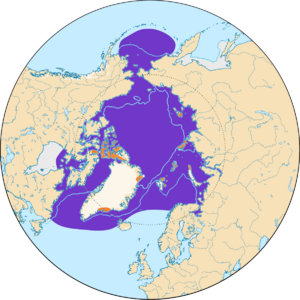Ivory gull facts for kids
Quick facts for kids Ivory gull |
|
|---|---|
 |
|
| Conservation status | |
| Scientific classification | |
| Genus: |
Pagophila
|
| Species: |
eburnea
|
 |
|
| Synonyms | |
|
|
The ivory gull (Pagophila eburnea) is a small, pure white gull. It's the only species in its group, called Pagophila. This bird lives and breeds in the very cold Arctic regions. You can find it all around the North Pole, including Greenland, northern North America, and Eurasia.
Contents
Discovering the Ivory Gull
The ivory gull was first described in 1774 by Constantine Phipps, 2nd Baron Mulgrave. He called it Larus eburneus. He found a specimen on Spitsbergen during his trip to the North Pole. Later, in 1829, a scientist named Johann Jakob Kaup noticed how special the ivory gull was. He gave it its own unique group, Pagophila.
The name Pagophila comes from Ancient Greek words. Pagos means "sea-ice," and philos means "-loving." So, Pagophila means "ice-loving." The word eburnea is Latin for "ivory-coloured," like the bird's feathers.
Scientists have studied the ivory gull's family tree. It seems to be most closely related to Sabine's gull. Other relatives include the kittiwakes and Ross's gull. Even though it has relatives, the ivory gull is kept in its own group. This is because it looks, acts, and lives differently from other gulls.
In some places, like Newfoundland, people have special names for this bird. They call it "slob gull" because it lives near "slob ice" (drift ice). They also call it "ice partridge" because it looks a bit like a ptarmigan.
What Does the Ivory Gull Look Like?
This bird is easy to spot because of its unique look. It's about 43 centimetres (17 in) (17 inches) long. Unlike other gulls, adult ivory gulls are completely white. They don't have any grey on their backs.
The ivory gull has a thick bill that is blue with a yellow tip. Its legs are black. During breeding season, its bill tip turns red. It also gets a bright red ring around its eyes.
This gull makes a harsh, tern-like keeeer sound when it flies. It has other calls too. One is a warbling "fox-call" that warns of danger. This call means a Arctic fox, polar bear, or other predator is nearby.
Young ivory gulls look a bit different. They have a dark face and some black spots on their wings and tail. It takes them two years to get their full white adult feathers. All ivory gulls look the same, no matter where they live.
Measurements:
- Length: 15.8–16.9 in (40–43 cm)
- Weight: 15.8–24.2 oz (450–690 g)
- Wingspan: 42.5–47.2 in (108–120 cm)
Where Ivory Gulls Live

In North America, ivory gulls only breed in the Canadian Arctic. The biggest known breeding place is Seymour Island, in Nunavut. They also breed on Ellesmere, Devon, Cornwallis, and northern Baffin islands. Scientists think there might be other small breeding spots that haven't been found yet. Ivory gulls have never been recorded breeding in Alaska.
In winter, ivory gulls stay near polynyas. These are large areas of open water surrounded by sea ice. Birds from North America, Greenland, and Europe spend winter along the ice edge. This ice edge stretches for about 2,000 km (1,240 miles). It goes from the Labrador Sea to Davis Strait.
You can often see wintering gulls on the eastern coasts of Newfoundland and Labrador. Sometimes they appear on the north shore of the Gulf of St. Lawrence. They also winter in the Bering Sea and Chukchi Seas. Young birds tend to travel further south from the Arctic than adults.
Ivory Gull Behavior and Diet
Ivory gulls don't migrate very far south in the autumn. Most of them spend winter in the northern parts of the world. They stay at the edge of the pack ice. Some birds do reach warmer areas, but not many.
What Ivory Gulls Eat
Ivory gulls eat fish and crustaceans. They also eat rodents, eggs, and small chicks. They are also scavengers, meaning they eat what other animals leave behind. You can often find them feeding on dead seal or porpoise bodies. They are known to follow polar bears and other predators. This way, they can eat the leftovers from their kills.
Reproduction and Life Cycle
The ivory gull builds its nest on Arctic coasts and cliffs. They lay one to three olive-colored eggs. Their nests are on the ground and are lined with moss, lichens, or seaweed.
Protecting the Ivory Gull
In 2012, there were an estimated 19,000 to 27,000 ivory gulls in the world. Most of these birds live in Russia. There are also about 4,000 in Greenland. In Canada, there were 500–700 birds recorded in 2002–03.
However, the number of ivory gulls has been falling quickly in Canada. In the early 2000s, the Canadian population was about 80% lower than in the 1980s. Scientists are worried about this decline.
One reason for the decline might be illegal hunting. Another big reason is the loss of sea ice. Ivory gulls breed near sea ice. When the ice melts, it becomes harder for them to find food for their chicks.
Because of these concerns, the International Union for Conservation of Nature has listed the ivory gull as "Near Threatened." This means they are close to becoming endangered.
Ivory Gulls in Books
An ivory gull was the inspiration for a special carving in a famous children's book. The book is called Seabird by Holling C. Holling. It even won the Newbery Medal!



